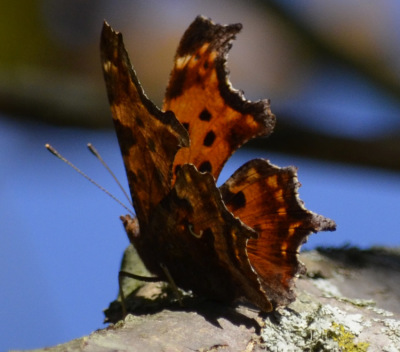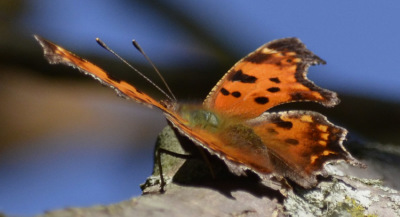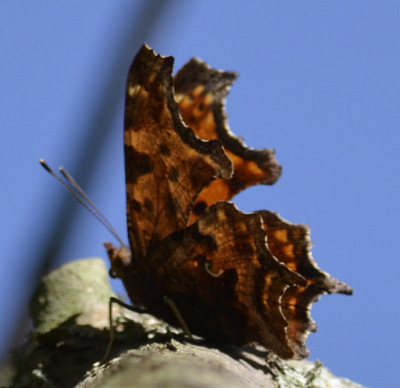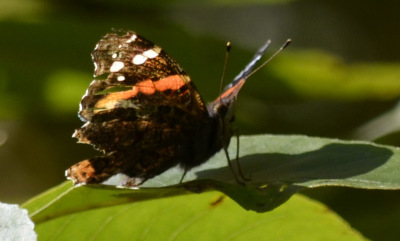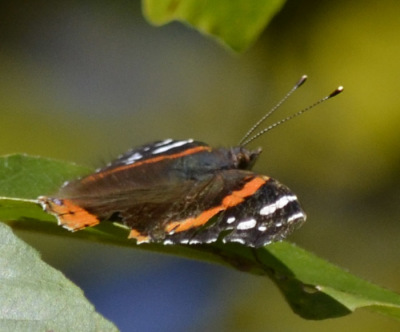Any butterfly can have real bites missing from its wings. They can also lose bits of wing when they collide with twigs and rocks. However, some butterflies’ wings always look irregularly shaped. Two common ones are mostly orange with black and light spots and black edges to their “bitten” wings.
Not All Butterflies Are Found On Flowers
In late September, I was walking along the boardwalk near the stream in the Rattray Marsh, in Mississauga, near Lake Ontario. A flash of orange against the blue sky caught my attention and I realized with pleased surprise that this was not another Monarch.
The butterfly perched on a tree branch high over head and I eventually managed to get a few photos through a small gap between twigs and leaves.
I could narrow down the type to either a Comma or a Question Mark. I hoped I might be able to figure out which one when I got home and could look at the photos zoomed in.
In the meantime, I watched the butterfly while several people walked by underneath oblivious to the beauty above them.
The Unknown Punctuation Mark shifted onto a leaf just before a person asked what was in the tree. I pointed out the silhouette the butterfly was making through the leaf. This impressed the couple as they thought I had found it based solely on the darkened outline. I admitted quickly that I had seen it when it flew from perch to perch.
Upon squinting at an enlarged view of the butterfly at home, I concluded it was likely a Comma. But which kind: Eastern, Green, Hoary or Gray? Well, you do like to ask the hard questions, don’t you?
Based on the dark stripe with large tan spots on the top of the hind wing, I don’t think it’s an Eastern. The wing edges also seem a bit too “jagged” to quote the Kaufman Field Guide.
The silvery “comma” mark on the underside is very clear even in these distant photos, so I think it’s unlikely to be a Gray Comma. The tan spots on the top of the hind wing also don’t fit that description well.
That leaves the Green Comma and the Hoary. Given that Green’s are more common, that’s what I’m voting for. I hope a Comma “expert” will read this some day and confirm which kind it is (if they can from these not-so-great photos.)
Not Only Monarchs Migrate: Keep an Eye Out for the Admirals
When I moved on, about 5 feet down the trail, a second butterfly passed overhead and landed in another tree. This one, though, was much easier to identify. It was a Red Admiral, likely migrating south like the Monarchs feeding from the goldenrod blossoms below.
The numbers of Red Admirals that migrate is not clearly understood. Ongoing research suggests that some may overwinter and others may migrate. Certainly the spring migration back north into southern Canada is easier to track than the fall southerly movement.
If you look closely at it, you’ll realize the wings of this Red Admiral are also irregular. Unfortunately, it is damage not a natural shape difference.
I didn’t see many birds on this walk through the early autumn woods but I still saw some flying beauties!
Related Reading
- On October Ontario Back Yard Full of Butterflies
- Questioning a Spotted Orange Spring Butterfly at Rattray Marsh
- Sexing Monarchs (Butterflies, That Is)
Join In
Has your fall been dotted with any colourful butterflies or moths? Please share your sightings with a comment.

